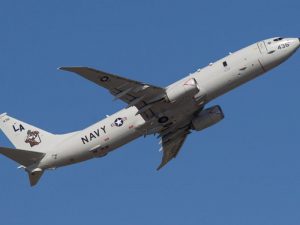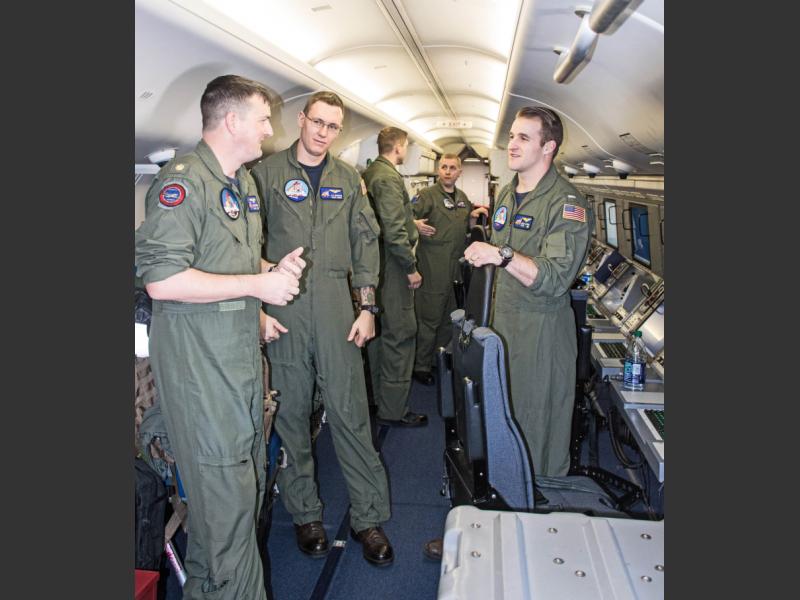2016-05-29 By Ed Timperlake and Robbin Laird
The great historian Max Hastings in a seminal book about all the fighting forces of World War II said that after some very nasty set backs early in the war, the US and Royal Navies emerged as the most effective fighting forces in the war.
We have often spoken of the US Navy’s combat operational goal in WW II of creating a Big Blue Blanket over the Pacific via a vast deployed fleet.
This now evolved into a “Big Blue ‘Tron’ Blanket.
https://sldinfo.com/wp-content/uploads/2014/11/21st-Century-Approach-to-Tron-Warfare.pdf
But what also can never be forgotten is the other war winning combat approach; the USN and RN Hunter-Killer teams of air and surface platforms working in harmony to win “The Battle of The Atlantic.”
In today’s 21s Century military world add in nuc attack subs, satellites and “remotes” and todays “Big Blue ‘Tron’ Blanket” and “Hunter-Killer Teams” now become global scalable “Kill Webs.”
When we visited at the end of March this year Admiral Gortney, NORTHCOM Commander and a proven fighting Carrier Admiral, he focused on the challenge of dealing with the threats at the 10 and 2 O’clock to North America.
He highlighted as well the centrality of shaping integrated air and maritime capabilities to deal with the threat and suggested that NORAD migrate from a pure air to an integrated air and sea command to deal with the 21st century challenges facing his command.
http://breakingdefense.com/2016/04/northcom-defending-north-america-at-ten-and-two-oclock/

When we visited Navy Jax, we were able to talk with those creating an effective response to the challenges highlighted by Admiral Gortney, namely the P-8/Triton community.
These maritime war fighting assets are key elements in the evolving approach to crate effective “kill webs” to address a very real and growing threat to North America.
And an important asset in shaping this way ahead is provided by the Maritime Patrol and Reconnaissance Weapons School (MPRWS) located in the Integrated Training Center.
In effect, this is where the Weapons and Tactics Instructors are being trained and shaped to win the tron wars being fought at 10 and 2 O’clock.
The training and successful use of all technology is ongoing a ensure that air-maritime force has both timely information, appropriate weapon technology and the appropriate level of decision con-ops it needs to deal with evolving threats.
We had a chance to interview Lt. Commander “KC” Campbell, the Weapons and Tactics Department Head, during our visit to the ITC.
http://www.navy.mil/submit/display.asp?story_id=52596
http://www.navy.mil/submit/display.asp?story_id=77993
Obviously, the major challenge facing the ITC is implementing the transition from P-3 to P-8/Triton.
Half of the squadrons have transitioned but that leaves another half to go.
But Lt. Commander Campbell is not taking his eye off of the ball of shaping a transformation approach as the new capability comes into the fleet.
He emphasized that the capability was new and there was a need to shape new tactics for the new capability.
He fully recognized the dynamic iterative nature of his mission.
For example, the P-3 flew to an area of interest and then went on station.
“With the P-8 when we take off we are already in the area of interest.
We already have a tactical picture from the Mobile Tactical Operations Center and we are already working within and on the common operating picture.
This is a change in capability; and needs a change in approach.”
The new capability especially as the USN-USMC team works towards enhanced capabilities in the extended battlespace requires shaping new techniques, new tactics and changing the mental furniture of the entire warfighting community.
To do this, Navy Jax deploys personnel from Jax to the fleet to interactively reshape thinking.
“I have a team of about 25 junior officers who spread out from Jax to the fleet and shape training nodes.
They make sure common tactics are implemented and standardized across the fleet.”
And in the process, of course, the fleet interacts with the P-8/Triton community to reshape concepts of operations going forward.
“There are cross-functional teams throughout the fleet which are working the evolution of tactics.”
Fallon Air Station is one key piece of the training effort where Jax sends instructors.
“In effect, a university structure is emerging at Fallon to look to integrate the new technologies, platforms and approaches in the shaping and application of new tactics.”
P-8 has been to Red Flag and is starting its migration into the joint and combined world as well.
And twice a year there is a weapons and tactics course.
Of course, there is always feedback on the effectiveness of tactics, techniques, and Procedures (TTPs) from the Fleet and then assure that operational improvements are standardized and then go back out to the squadrons.
In effect, the P-8/Triton team is shaping a common approach or “theory” of ISR and C2 applied to the extended battlespace; and the two platforms are the applications of the theory.
In short, the USN is positioning itself for an innovative way ahead that is neither “manned or unmanned” but synergistically working through how new systems can work with one another to deliver the desired outcome or effect in the battlespace, notably in the ISR, C2 and anti-submarine domains.
Editor’s Note: The P-8s are deploying and learning with the Fleet as Lt. Commander Campbell has described.
One example of this deployment and learning cycle was with the Truman battle group last fall.
According to an article by the VP-5 PAO published 10/14/15 in the Jax Air News:
As September drew to a close; so did the Harry S. Truman Composite Training Unit Exercise (COMPTUEX). During the exercise, the “Mad Foxes” of VP-5 and “Fighting Tigers” of VP-8 provided real time support for anti-submarine warfare (ASW), anti-surface warfare (ASuW), and maritime Intelligence Surveillance and Reconnaissance (ISR) to the Carrier Strike Group (CSG) 8.
Patrol Squadron (VP) 5 Commanding Officer Cmdr. Alan D’Jock, stated, “I could not be more proud of the VP-5, VP-8, and Mobile Tactical Operations Center (MTOC-3) “Mad Tiger” team. We look forward to deploying with the Fighting Tigers and continuing our relationship throughout the remainder of our home cycle and next year’s deployment.”

The VP-5 and VP-8 Mad Tiger team was well prepared for the uncertainties of such a dynamic environment. A contributing factor to the success of the exercise was due to the VP liaison officers (LNOs) aboard Harry S. Truman.
These individuals were led by Cmdr. Alan Miller, executive officer of VP-10 and provided enhanced communication between CSG8 and the maritime patrol reconnaissance aircraft. Each crew was able to adapt to and overcome potential problems that may arise such as formidable weather or simulated hostile contacts.
“The experience that VP-5 and VP-8 garnered from COMPTUEX is invaluable. What our aircrews saw on station is very difficult to duplicate in a simulated training environment,” remarked D’Jock.
VP-5 and VP-8 provided 532.8 flight hours from 73 events to the exercise. The squadron’s participation was a valuable asset to both the surface forces, as well as to the aircrews in the aircraft.
AWO3 Dymer, an electronics warfare officer with VP-5, said, “Being a part of the exercise was physically and mentally demanding but also taught some of the most senior crews lessons and tips for real world scenarios. It opened the eyes of many new sailors by showing the massive coordination required to accomplish many jobs.”
With this exercise complete, Oct. 2, VP-5 and VP-8 continued their training for a successful deployment next year. The Mad Foxes of VP-5 and Fighting Tigers of VP-8 will continue training, and participating in exercises abroad as well as at home.
And as Lt. Commander Campbell noted, the P-8s have started their joint learning engagements in Red Flag.
The slideshow above highlights the Pelicans engagement in Red Flag earlier this year.
In an article published March 30, 2016 and written by the PAO of VP-45 and published in the Jax Air News, the first deployment to Red Flag was described:
Members of Patrol Squadron (VP) 45 participated in Red Flag 16-1 at Nellis Air Force Base (AFB), Nev., Jan. 25through Feb.12, with the Navy’s newest maritime patrol aircraft, the P-8A Poseidon.
As part of the squadron’s Fleet Response Training Plan home cycle, Red Flag is an exercise held periodically at Nellis AFB since 1975. The exercise provides pilots, aircrews and support personnel from the U.S. and allied countries the opportunity to practice their skills in a simulated combat environment.
“These scenarios largely involved the P-8 performing advanced intelligence, surveillance and reconnaissance (ISR) missions and preparing the battlespace with timely and accurate information on threats to multiple platforms,” said Lt. Cmdr. Annie Gilson, a naval flight officer with VP-45.
“These platforms were able to use this information to neutralize targets more efficiently and effectively in a highly dynamic environment.”
Those in attendance of this year’s Red Flag exercise were members from the U.S. Air Force, U.S. Navy, Royal Australian Air Force and United Kingdom Royal Air Force.
“Working with the foreign militaries provided a better understanding of what they do,” said AWO2 Irma Sanchez, acoustic operator with VP-45. “Getting an opportunity to work with these militaries was a real eye opener into the bigger picture.”
“As a squadron, I feel that we did really well,” said Sanchez. “For our first Red Flag exercise as a P-8 squadron, I felt that we exceeded the standards that were set for us.”
Participants said one of the reasons VP-45 had such a successful exercise was because of their ability to work as a team.
“During Red Flag, our communication and capability to work together was very important,” said AWO2 Mathew Pereida, a VP-45 electronic warfare operator. “Working together as a team led to successful takeoff times, mission completeness, and overall coordinated operations effectiveness.”
Overall, members of VP-45 felt Red Flag has prepared them for the future.
“Red Flag does a great job of detecting and resolving squadron and aircraft deficiencies and how we can improve,” said AWO2 Jason Foor, “It really showed us what level we are operating at and where we can be in the future.”
For the USMC approach to Tron Warfare in the distributed battlespace, see the following:
https://sldinfo.com/ea-6b-prowlers-in-final-four-flight/
https://sldinfo.com/visiting-2nd-marine-air-wing-the-role-of-electronic-warfare-and-vmaq-3/
https://sldinfo.com/the-deputy-commandant-of-aviation-down-under-plan-jericho-marine-corps-style/




